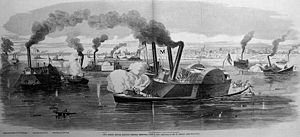CSS Little Rebel

Battle of Memphis; Little Rebel is third vessel from the left.
|
|
| History | |
|---|---|
|
|
|
| Name: | CSS Little Rebel |
| Launched: | 1859 |
| Acquired: | January 1862 |
| Commissioned: | 1862 |
| Fate: | Captured, 6 June 1862 |
|
|
|
| Name: | USS Little Rebel |
| Acquired: | 6 June 1862 |
| Commissioned: | 9 January 1863 |
| Decommissioned: | 24 July 1865 |
| Fate: | Sold into merchant service, 29 November 1865 |
| General characteristics | |
| Type: | Cotton-clad ram |
| Displacement: | 161 long tons (164 t) |
| Draft: | 12 ft (3.7 m) |
| Propulsion: | Steam engine, screw-propelled |
| Speed: | 12 knots (22 km/h; 14 mph) |
| Armament: | 3 × 12-pounder guns |
Little Rebel was a cotton-clad ram that had been converted from a Mississippi River steamer to serve as the flagship of the Confederate River Defense Fleet in the American Civil War. Sent from New Orleans to defend against the Federal descent of the Mississippi, she was among the force that engaged vessels of the Union Army's Western Gunboat Flotilla at the Battle of Plum Point Bend on May 10, 1862. On June 6, she again was involved in an action with the Federal gunboats, this time at the Battle of Memphis. In the battle, a shot from a Federal gun pierced her boiler, disabling her, and she was then pushed aground by the Federal ram USS Monarch and captured.
Subsequently repaired and taken into the Union Navy, she served through the remainder of the war, seeing only limited action. After the war, she was deemed surplus by the Navy Department. Sold, she reentered the merchant service, where she remained until 1874.
Little Rebel was built as R. E. and A. N. Watson at Belle Vernon, Pennsylvania, in 1859. She was acquired at New Orleans, Louisiana, by the Confederate Army in January 1862, and selected by Captain James E. Montgomery, a Mississippi River boatman, to be part of his River Defense Fleet. On January 25, 1862, Montgomery began her conversion to a cotton-clad ram by placing a 4-inch oak sheath with a 1-inch iron covering on her bow, and by installing double pine bulkheads filled with compressed cotton bales to protect her engines.
On April 11, Little Rebel's conversion was completed and she steamed from New Orleans to Fort Pillow, Tennessee, where she operated in defense of the river approaches to Memphis. On May 10, 1862, off Fort Pillow, Little Rebel, in company with seven other vessels under Captain Montgomery, attacked the ironclad gunboats of the Federal Western Gunboat Flotilla. The action of Plum Point Bend was marked by successful ramming tactics by the Confederates, but Little Rebel, under Captain J. White Fowler, serving as Montgomery's flagship, was unable to get into the battle except with her guns. Brigadier General M. Jeff Thompson, CSA, who witnessed the battle said that Little Rebel, under a shower of enemy missiles, "ran amid the storm as heedlessly as if charmed." Meanwhile, her guns supported Montgomery's other vessels which were ramming Union boats.
...
Wikipedia
